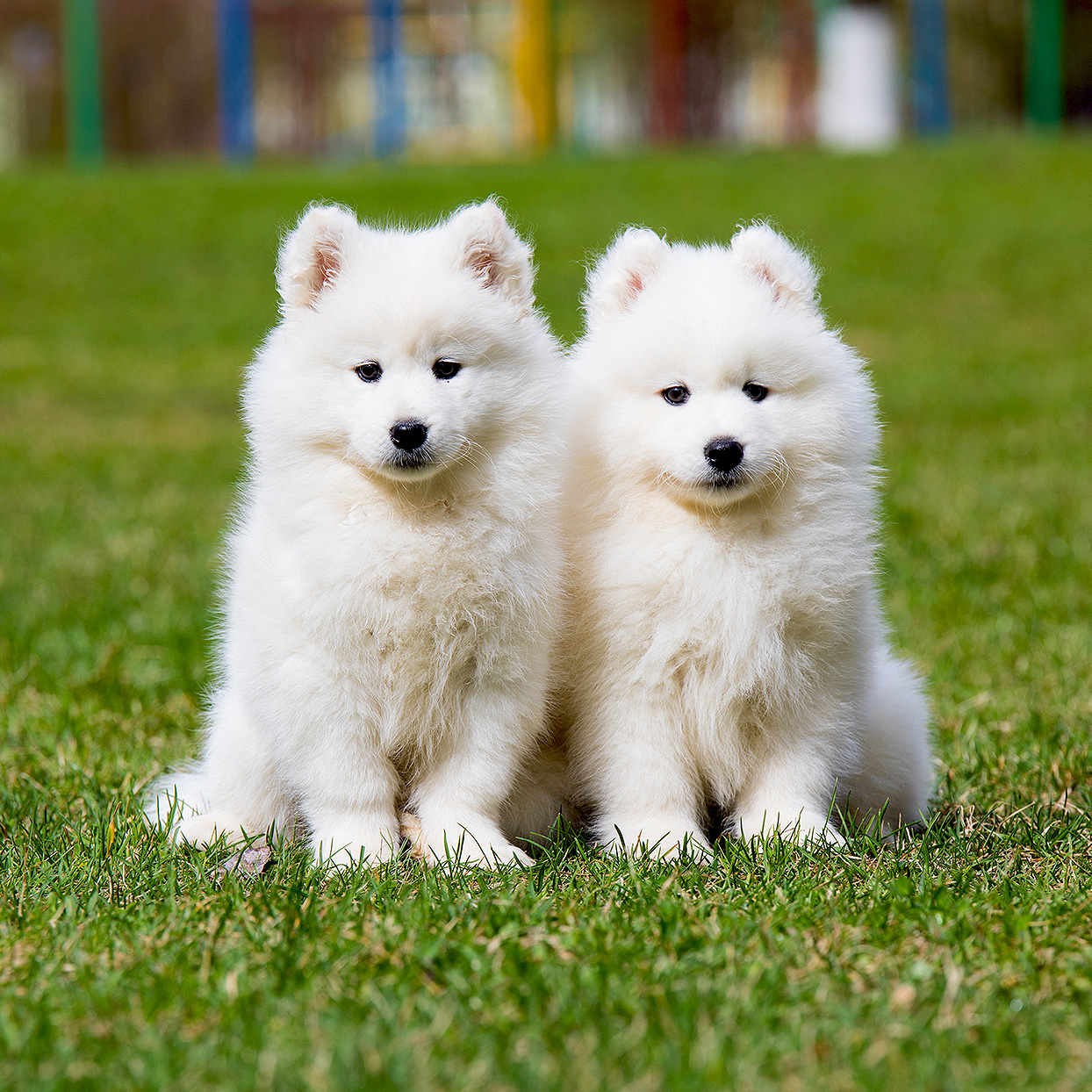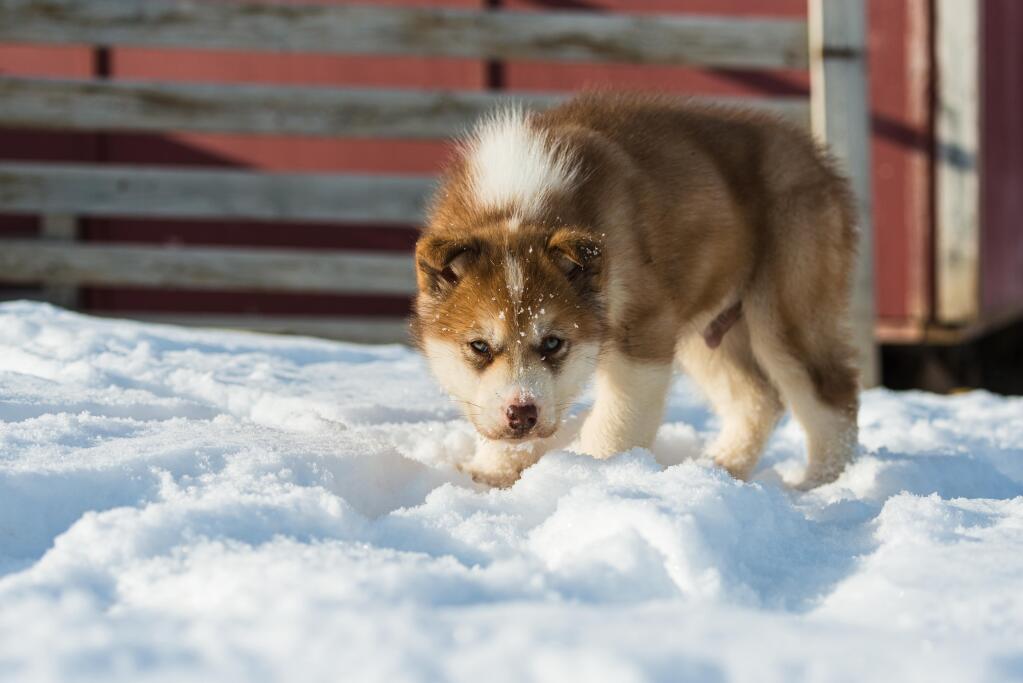Information about the breeds we sell
How to take care of a Alaskan Husky

The Alaskan Husky is easy to groom. Brush him once or twice a week to remove dead hair. He’ll shed heavily twice a year, and during that time you’ll want to brush him more often to keep the loose hair under control. The only other grooming he needs is regular nail trimming, ear cleaning and dental hygiene.
Health problems that may affect Alaskan Huskies include lysosomal storage disease; various eye problems, including progressive retinal atrophy; and hypothyroidism, a common hormonal disorder in dogs.
Facts about Alaskan Huskies
- Alaskan huskies weigh around 40 – 60 pounds as adults
- Alaskan huskies come in a wide variety of colors
- Alaskan huskies are currently the most popular sled dog breed
- Alaskan huskies can live up to 15 years.
How to take care of Alaskan Malamute

The pivotal part of being a Malamute parent is exercise, exercise, and more exercise. Malamutes were bred to work hard and do tough jobs, so being active and staying busy comes naturally. If your busy-bee of a friend isn’t allowed to burn off their extra energy, then they will most likely become disruptive and destructive.
Health problems that effect Alaskan Malamute are sensitive skin, lameness, digestive issues, arthritis, hypothyroidism
Facts about Alaskan Malamutes
- The Alaskan malamute is the state dog of Alaska
- Alaskan malamutes weigh around 75-85 pounds
- Alaskan Malamutes are named after the native Innuit tribe called Mahlemuts
- The average life expectancy is 10 -14 years.
How to take care of Alaskan Klee Kai

They need a minimal brushing and combing once a week. Like cats, they are fastidious and keep themselves clean.
Klee kai are ideal for owners who want a small, active dog that does not require a large yard and can be content with walks and games of fetch. klee kai do not do well left alone for long periods. Anyone who cannot tolerate dog hair and shedding should consider another breed.
Health problems that effect Alaskan Klee Kai are patellar luxation, autoimmune thyroiditis, heart murmurs, eye diseases, Factor VII deficiency (a bleeding disorder)
Facts about Alaskan Klee Kai
- Alaskan Klee Kai weigh around 6-25 pounds
- Alaskan Klee Kai live around 13-16 years
- Alaskan Klee Kai means “small dog” in Alaskan Athabaskan
- Alaskan Klee Kai are also referred to as escape artists
How to take care of American Eskimo Dog

This coat needs to be bathed and brushed weekly in order to prevent the dog from becoming matted and tangled.
There are two common conditions that affect the breed, we can find hip dysplasia and progressive retinal atrophy
Facts about American Eskimo Dogs
- They originated in Germany
- They were the first dog to be known to walk across a tightrope
- They live around 13-15 years
- They weigh around 6-35 pounds
How to take care of Siberian Huskies

Overall the Siberian Husky needs very little grooming compared to other breeds, no trimming of hair is needed, just a regular brush to remove any dead hair. Do not shave, strip or clip your husky close.
Health problems that effect Siberian Huskies cancer,degenerative myelopathy, and eye diseases
Facts about Siberian Huskies
- They live around 12-14 years
- They weigh around 35-60 pounds
- They are really friendly
- They have a coat of fur that is naturally clean and doesn’t need trimming or clipping
How to take care of samoyeds

Samoyeds are very high maintenance when it comes to grooming because of their thick, fluffy coats. They shed very often, but even when they’re not shedding they’ll need grooming on daily basis. The hair between their paw pads may also need trimming regularly
Health problems that effect Samyoed are hip dysplasia,arthritis, diabetes, certain cancers, and eye problems
Facts about Samoyeds
- They live around 12-14 years
- They weigh around 35 – 65 pounds
- They thrive on human company
- They are herding dogs
How to take care of Greenland Huskies

They only requires brushing 2-3 times a week and a bath every 3-4 months.
Health problems that effect Greenland Huskies are glaucoma, lens luxation, gastric torsion (bloat) and joint dysplasia of the hips and elbows
Facts about Greenland Huskies
- They live around 13 years
- They weigh around 66-70 pounds
- They are aloof and independent
- They don’t really have guard dog mentality
How to take care of Seppala Siberian Sled dog

be prepared to brush your dog each day, and leave your vacuum on standby! Apart from that, the Seppala is easy to maintain.
Health problems that effect Seppala Siberian sled dogs is cancer
Facts about Seppala Siberian Sled Dogs
- They live around 12 – 16 years
- They weigh around 40 – 50 pounds
- They used to just be recognized as Siberian huskies but it is its own breed now
- They are really friendly
For more information on our dogs check out these links
- Infomation on Alaskan Huskies
- Information on Alaskan Malamutes
- Information on Alaskan Klee Kai
- Information on American Eskimo dogs
- Infomation on Siberian Huskies
- Information on Samoyeds
- Information on Greenland huskies
- Information on Seppala Siberian sled dogs
This is for educational purposes only
